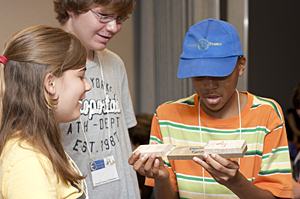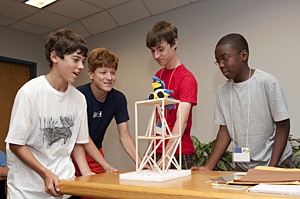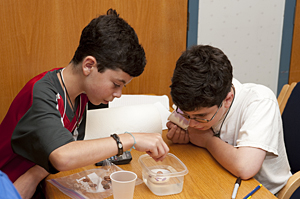

ADVERTISEMENT
- Rozovsky wins prestigious NSF Early Career Award
- UD students meet alumni, experience 'closing bell' at NYSE
- Newark Police seek assistance in identifying suspects in robbery
- Rivlin says bipartisan budget action, stronger budget rules key to reversing debt
- Stink bugs shouldn't pose problem until late summer
- Gao to honor Placido Domingo in Washington performance
- Adopt-A-Highway project keeps Lewes road clean
- WVUD's Radiothon fundraiser runs April 1-10
- W.D. Snodgrass Symposium to honor Pulitzer winner
- New guide helps cancer patients manage symptoms
- UD in the News, March 25, 2011
- For the Record, March 25, 2011
- Public opinion expert discusses world views of U.S. in Global Agenda series
- Congressional delegation, dean laud Center for Community Research and Service program
- Center for Political Communication sets symposium on politics, entertainment
- Students work to raise funds, awareness of domestic violence
- Equestrian team wins regional championship in Western riding
- Markell, Harker stress importance of agriculture to Delaware's economy
- Carol A. Ammon MBA Case Competition winners announced
- Prof presents blood-clotting studies at Gordon Research Conference
- Sexual Assault Awareness Month events, programs announced
- Stay connected with Sea Grant, CEOE e-newsletter
- A message to UD regarding the tragedy in Japan
- More News >>
- March 31-May 14: REP stages Neil Simon's 'The Good Doctor'
- April 2: Newark plans annual 'wine and dine'
- April 5: Expert perspective on U.S. health care
- April 5: Comedian Ace Guillen to visit Scrounge
- April 6, May 4: School of Nursing sponsors research lecture series
- April 6-May 4: Confucius Institute presents Chinese Film Series on Wednesdays
- April 6: IPCC's Pachauri to discuss sustainable development in DENIN Dialogue Series
- April 7: 'WVUDstock' radiothon concert announced
- April 8: English Language Institute presents 'Arts in Translation'
- April 9: Green and Healthy Living Expo planned at The Bob
- April 9: Center for Political Communication to host Onion editor
- April 10: Alumni Easter Egg-stravaganza planned
- April 11: CDS session to focus on visual assistive technologies
- April 12: T.J. Stiles to speak at UDLA annual dinner
- April 15, 16: Annual UD push lawnmower tune-up scheduled
- April 15, 16: Master Players series presents iMusic 4, China Magpie
- April 15, 16: Delaware Symphony, UD chorus to perform Mahler work
- April 18: Former NFL Coach Bill Cowher featured in UD Speaks
- April 21-24: Sesame Street Live brings Elmo and friends to The Bob
- April 30: Save the date for Ag Day 2011 at UD
- April 30: Symposium to consider 'Frontiers at the Chemistry-Biology Interface'
- April 30-May 1: Relay for Life set at Delaware Field House
- May 4: Delaware Membrane Protein Symposium announced
- May 5: Northwestern University's Leon Keer to deliver Kerr lecture
- May 7: Women's volleyball team to host second annual Spring Fling
- Through May 3: SPPA announces speakers for 10th annual lecture series
- Through May 4: Global Agenda sees U.S. through others' eyes; World Bank president to speak
- Through May 4: 'Research on Race, Ethnicity, Culture' topic of series
- Through May 9: Black American Studies announces lecture series
- Through May 11: 'Challenges in Jewish Culture' lecture series announced
- Through May 11: Area Studies research featured in speaker series
- Through June 5: 'Andy Warhol: Behind the Camera' on view in Old College Gallery
- Through July 15: 'Bodyscapes' on view at Mechanical Hall Gallery
- More What's Happening >>
- UD calendar >>
- Middle States evaluation team on campus April 5
- Phipps named HR Liaison of the Quarter
- Senior wins iPad for participating in assessment study
- April 19: Procurement Services schedules information sessions
- UD Bookstore announces spring break hours
- HealthyU Wellness Program encourages employees to 'Step into Spring'
- April 8-29: Faculty roundtable series considers student engagement
- GRE is changing; learn more at April 15 info session
- April 30: UD Evening with Blue Rocks set for employees
- Morris Library to be open 24/7 during final exams
- More Campus FYI >>
9:41 a.m., Aug. 6, 2010----Now in its fifth year, the Engineering Cool Stuff Camp at the University of Delaware continues to welcome and engage the engineers of tomorrow through a program that combines hands-on experiments, youthful enthusiasm and teamwork.
During the Engineering Outreach-sponsored camp, which ran from July 12-16 and July 19-23, participants ages 12-16 used their math and science savvy and basic engineering principles to design and build everything from solar-powered lights to earthquake-resistant structures.
While the students seemed to enjoy all aspects of the camp, some popular activities included:
* Designing, building and racing solar cars and a solar electric system to power a light, with the help of students from the Integrative Graduate Education and Research Traineeship (IGERT) program at UD;
* Designing, building and testing composite sandwich structures and composite beams, facilitated by members of the UD student chapter of the Society for the Advancement of Material and Process Engineering (SAMPE); and
* Designing, building and testing bridges and earthquake-proof towers, facilitated by structural engineering students led by Patrick Carson, a doctoral engineering student in the group led by Harry W. “Tripp” Shenton, professor and chairperson of the Department of Civil and Environmental Engineering.
Composite beams measured
Students got to see how well their completed composite structures held up when subjected to pressure testing using equipment in the Composites Manufacturing Science Laboratory on UD's Newark campus.
Having designed the composite beams to be as light and effective per weight as possible, students explained why some of the structures fared better than others.
The Unbreakables were a credit to their team name with their winning combination of balsa wood, fiberglass, foam and aluminum. The team earned top bragging rights by building the sandwich structure with the best weight-to-strength ratio.
The team roster included Caesare Pineda of Salesianum School, Barry Moe from the Wilmington Charter School, Colleen Murray of the Immaculate Conception School in Elkton, Md., and Tre Jackson from Shue-Medill Middle School in Newark.
“We kept all the pieces in the shapes in which they were given to us,” Jackson said. “These elements were held together with resin glue. We tried to determine which combination was the lightest and strongest.”
Like his teammates, Jackson's favorite classes are math and science. Plans include attending Newark High School and possibly joining the Army.
For Pineda, who would like to go to MIT, the most interesting activity of the camp was working on a solar panel. “We had to use cords and wires to create a light,” he said.
Murray, who plans to attend Padua High School and pursue a teaching career, said, “The camp is fun, and we get to do a lot of different things.”
Moe, who would like to attend the University of Colorado, said, “The whole camp has been interesting. I like working with others, and having the winning entry was really exciting.” Moe was one of several students attending the camp for the second summer.
Learning about lifeboats
Campers also learned about the importance of proper lifeboat design and placement by studying how inadequate designs and lack of passenger lifeboat drills led to the loss of life during the sinking of the Titanic nearly a century ago.
Displaying an astute knowledge of the Titanic's history, campers watched a YouTube video “Titanic Lifeboats,” which detailed the launching of lifeboats following the ship's collision with an iceberg at 11:40 p.m., on the night of April 14, 1912.
The ill-fated luxury liner carried only 20 lifeboats, each with a 65-person capacity, which meant that more than half of the ship's 2,200 passengers and crew went down when the Titanic sank just over two hours later.
The video also noted that only 18 lifeboats were launched, with many carrying less than the maximum number of possible passengers, while a few carried more than the rated limit.
Against this introductory background, students were given specific measurements to design, build and test lifeboats.
Camp still growing
“We've grown from a one-session camp of 20 kids in 2006, to having two sessions of 35 students each this year,” Kathy Werrell, assistant dean for Engineering Outreach Pre-college and Special Programs, said. “With the larger enrollment, we had to provide more activities, so we split the number of students in half each week, rotating them through the activities and giving everyone a chance at every activity while preserving that small-group, individualized attention feel that campers like.”
Camper comments, courtesy of Melissa A. Jurist, outreach coordinator in the College of Engineering, were universally positive. One camper “learned a lot about biofuels, composites and more,” and another said they were “always doing neat things.” One noted the camp was “way more fun than you would expect.”
One parent said, “My son could not stop talking about it. Please put us on the list for next year,” and another noted their child “came away inspired and excited every day. What a wonderful and invaluable experience they had.”
Article by Jerry Rhodes
Photos by Kathy F. Atkinson



